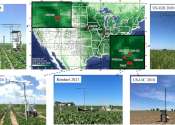Photosynthesis[α] is a process that converts carbon dioxide into organic compounds, especially sugars, using the energy from sunlight. Photosynthesis occurs in plants, algae, and many species of Bacteria, but not in Archaea. Photosynthetic organisms are called photoautotrophs, since it allows them to create their own food. In plants, algae and cyanobacteria photosynthesis uses carbon dioxide and water, releasing oxygen as a waste product. Photosynthesis is vital for life on Earth. As well as maintaining the normal level of oxygen in the atmosphere, nearly all life either depends on it directly as a source of energy, or indirectly as the ultimate source of the energy in their food.[β] The amount of energy trapped by photosynthesis is immense, approximately 100 terawatts: which is about six times larger than the power consumption of human civilization. As well as energy, photosynthesis is also the source of the carbon in all the organic compounds within organisms' bodies. In all, photosynthetic organisms convert around 100,000,000,000 tonnes of carbon into biomass per year.
Although photosynthesis can occur in different ways in different species, some features are always the same. For example, the process always begins when energy from light is absorbed by proteins called photosynthetic reaction centers that contain chlorophylls. In plants, these proteins are held inside organelles called chloroplasts, while in bacteria they are embedded in the plasma membrane. Some of the light energy gathered by chlorophylls is stored in the form of adenosine triphosphate (ATP). The rest of the energy is used to remove electrons from a substance such as water. These electrons are then used in the reactions that turn carbon dioxide into organic compounds. In plants, algae and cyanobacteria this is done by a sequence of reactions called the Calvin cycle, but different sets of reactions are found in some bacteria, such as the reverse Krebs cycle in Chlorobium. Many photosynthetic organisms have adaptations that concentrate or store carbon dioxide. This helps reduce a wasteful process called photorespiration that can consume part of the sugar produced during photosynthesis.
Photosynthesis evolved early in the evolutionary history of life, when all forms of life on Earth were microorganisms and the atmosphere had much more carbon dioxide. The first photosynthetic organisms probably evolved about 3,500 million years ago, and used hydrogen or hydrogen sulfide as sources of electrons, rather than water. Cyanobacteria appeared later, around 3,000 million years ago, and changed the Earth forever when they began to oxygenate the atmosphere, beginning about 2,400 million years ago. This new atmosphere allowed the evolution of complex life such as protists. Eventually, about 550 million years ago, one of these protists formed a symbiotic relationship with a cyanobacterium, producing the ancestor of the plants and algae. The chloroplasts in modern plants are the descendants of these ancient symbiotic cyanobacteria.









